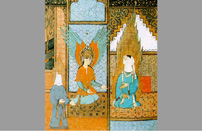Introduction
Analyzing Evidence presents case studies that demonstrate how scholars interpret different kinds of historical evidence in world history. On this screen, you see a Hadith. Hadith are reports about what the Prophet Muhammad said or thought. They provide Muslims with a sense of how Muhammad applied the guidelines of the Koran to daily life. They are based on the memories and stories of those who knew the Prophet and were recorded a few generations after his death. Women in the Prophet’s family are acknowledged as legitimate authors of these religious texts, and they provide a glimpse into the roles that Muslim women played in the early Islamic period.
In the second image, you see a depiction of A’isha, one of Muhammad’s wives. She was close to the Prophet and is the author of roughly 1,200 Hadith. Her involvement tells us something about the public role that some women played in the early Muslim community and the respect she was given.
As you read this Hadith and look at the image of A’isha, think about the role of Hadith and what kinds of issues they address. What does this Hadith tell us about A’isha’s relationship to the religious practices of the time? About her confidence as a narrator? Does this Hadith challenge common stereotypes about Muslim women?
Now listen to Professor Sumaiya Hamdani analyze these Hadith.
Note: This site uses Flash. For slower connections, visit the non-flash version.




